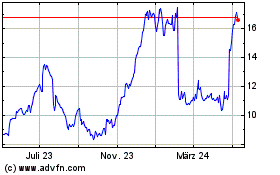Snap Stock Plunges Post Q2 Results
01 August 2022 - 11:36AM
Finscreener.org
It’s not inconceivable
that Snap (NYSE:
SNAP) shareholders think
they are on a rollercoaster. This social network stock has been
very volatile in the past year.
Snap stock rose from $10 per
share in March 2020 to $83 in September 2021. ItU+02019s currently
trading at $9.88 per share at the time of writing. Snap earnings
day was a disappointment in July, and it crashed 39% in a single
trading session last month.
That’s been Snap’s story in 2022.
The stock has always shown glimpses of potential, which makes it
rise, but these glimpses are followed by long periods of
disappointment. The stock has fallen almost 79% this
year.
Snap missed estimates in Q2
Snap reported its Q2 numbers
after market close on Thursday, July 21. Revenue came in at $1.11
billion compared to analyst estimates of $1.14 billion. Revenue was
up 13% compared to the corresponding quarter in 2021, but top-line
growth is slowing down. For example, sales in Q1 grew 38%
year-over-year.
Further, the average revenue per
user was down 4.5%. And the most damming factor was the fact that
Snap didn’t give Q3 guidance. Instead, CEO Evan Spiegel said, in a
release, “While the continued growth of our community increases the
long-term opportunity for our business, our financial results for
Q2 do not reflect our ambition.”
One inexplicable announcement was
a $500 million stock buyback program. Snap reported an adjusted EPS
of -$0.02 in the June quarter as net losses came in at $422 million
compared to $152 million in the year-ago period. At a time when
growth is slowing down, and the business environment is uncertain,
a company would ideally shore up its cash reserves instead of
spending it on a stock buyback program. As of June 30, 2022, Snap
had $4.9 billion in cash and equivalents.
Is it all bad for Snap stock and investors?
Snap’s number of daily active
users came in at 347 million versus an estimated 343.2 million. It
also said, “The daily average number of Snapchatters aged 25 and
older engaging with shows and publisher content increased by more
than 40% year-over-year.” The dark lining here is that the company
hasn’t figured out how to monetize them.
The company is betting big on AR
(Augmented Reality). It launched Lens Cloud, a collection of
backend services that expands AR experiences developers can create.
Snap has tied up with brands like Vogue and Tiffany with different
offerings.
Earlier in 2022, Snap estimated
revenue growth of 18% for Q2. However, the company said it would
likely miss its guidance and alluded to a shaky business
environment on May 23. It had filed a letter with the SEC that
said, “The macroeconomic environment has deteriorated further and
faster than anticipated.” The letter said that Apple’s privacy
policy changes made it harder to sell targeted advertising, and
demand was slowing down.
Snap’s quarterly letter to
shareholders said, “We are also seeing increasing competition for
advertising dollars that are now growing more slowly.” This is an
indication of the pressure TikTok is exerting on its
peers.
Snap depends a lot on large
brands for its advertising. In an economy still struggling with
supply-chain issues, high inflation, rising interest rates, and a
potential recession, it is likely that these brands will cut down
on their ad budgets leading to more pain for Snap.
The average consensus target for
Snap stock is $25.3, a potential upside of over 154%. Snap is a
stock with a tremendous payoff, but it also comes with a lot of
risks.
Snap (NYSE:SNAP)
Historical Stock Chart
Von Mär 2024 bis Apr 2024

Snap (NYSE:SNAP)
Historical Stock Chart
Von Apr 2023 bis Apr 2024
